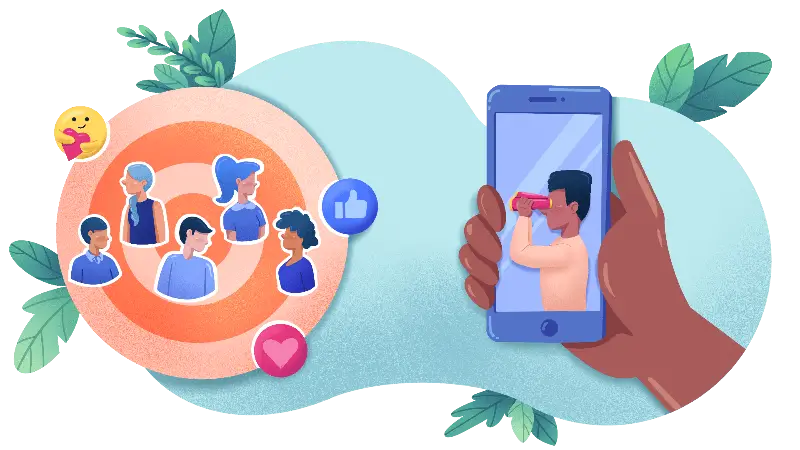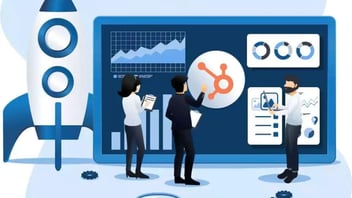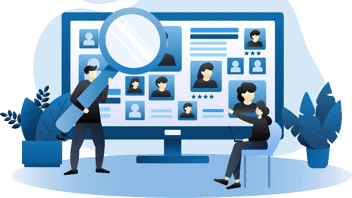How to Build Buyer Persona Profiles and Personalize Marketing Messages
To create marketing that truly converts and builds lasting relationships, you need more than just raw data–you need genuine understanding. Buyer personas provide this crucial layer of insight, transforming raw information about your target audience into actionable knowledge about their needs, pain points, and aspirations.
These detailed profiles become the foundational element for all your communication efforts, ensuring your messages are relevant, timely, and impactful.
Understanding the "Why" and "Who"
Customers today are bombarded with countless messages daily, making generic marketing efforts increasingly ineffective. So, why is a deep understanding of your audience so critical? A staggering 81% of consumers report ignoring ads that are not relevant to them. This statistic underscores a fundamental truth–in a crowded marketplace, messages that don't resonate with individual needs and interests are simply tuned out.
Conversely, the impact of personalized marketing is undeniable. Research indicates that companies that personalize marketing messages see a remarkable 18% uplift in revenue. This isn't just about getting attention but forging genuine connections that lead to tangible results. Imagine a clothing retailer sending a generic email blast about their new arrivals to their entire subscriber list. A segment of their audience, who primarily purchase athletic wear, will likely disregard the email.
However, if they had segmented their audience and sent a targeted email showcasing new running gear to their athletic wear enthusiasts, the chances of engagement and conversion would be significantly higher. The difference lies in understanding who you're talking to and what truly matters to them.
Defining Your Ideal Customer Profile (ICP)
Before diving into individual buyer personas, it's beneficial to establish your ideal customer profile (ICP). Think of your ICP as a high-level description of the type of organization or individual that represents your best customer. This profile outlines the key characteristics that make a customer a perfect fit for your product or service, often focusing on firmographic data for B2B companies (like industry, company size, revenue) or broad demographic and behavioral traits for B2C businesses.
The ICP serves as a crucial foundation, providing a broad framework that guides the subsequent creation of more detailed buyer personas. For instance, a SaaS company might define its ICP as "small to medium-sized businesses in the tech industry with 50-200 employees and a clear need for project management software to improve team collaboration and efficiency." This ICP helps narrow down the overall target market and identifies the general characteristics of companies that are most likely to find value in their offering. This understanding then informs the next step: fleshing out the specific individuals within these organizations or segments.
ICP vs. Buyer Persona
While the ideal customer profile provides a valuable overarching view of your best customer type, the buyer persona delves into the specifics of the individuals within that profile. Here's a table summarizing the key differences:
| Feature | Ideal Customer Profile (ICP) | Buyer Persona |
| Focus | Ideal customer type (organization or broad segment) | Specific, fictional individual within that customer type |
| Level of Detail | High-level characteristics | Detailed attributes, motivations, challenges, goals, behaviors |
| Data Points | Firmographics (B2B), broad demographics/behavior (B2C) | Job title, responsibilities, pain points, information sources, etc. |
| Representation | Often a bulleted list of key attributes | A narrative profile with a name and sometimes a photo |
| Purpose | To define the overall target for your product/service | To humanize the target audience and inform marketing messaging |
| Analogy | The blueprint of a house (overall structure and features) | The family living inside the house (their needs and lifestyle) |
While the ICP defines the ideal structure, it's the understanding of the family (buyer persona) that truly informs how you furnish the house and make it a home. Similarly, while the ICP defines the ideal customer type, it's the detailed buyer persona that allows you to craft marketing messages that truly resonate with the human beings you are trying to reach.
Step-by-Step Guide to Building Robust Buyer Persona Profiles
Building truly insightful buyer persona profiles requires a commitment to thorough investigation that goes far beyond surface-level details. It's about understanding the nuanced realities of your ideal customers.
Step 1: Conduct Thorough Research
While basic demographics like age, gender, and location can offer a starting point, they rarely paint a complete picture of your audience's motivations and behaviors. To build truly robust personas, you need to dig deeper through a variety of research methods.
-
Customer Interviews: Direct conversations with your current and potential customers are invaluable. These qualitative insights can uncover the "why" behind their actions. By engaging in thoughtful dialogue, you can understand their challenges in their own words, their aspirations, and the context in which they make decisions.
-
Surveys and Questionnaires: Surveys allow you to gather both quantitative and qualitative data from a larger audience. Well-designed surveys can validate the insights gained from interviews and uncover broader trends.
-
Analyzing Existing Data: Your existing data is a goldmine of information about your customers. By carefully analyzing it, you can identify patterns and gain valuable insights. Website analytics can reveal how different segments of your audience interact with your content–which pages they visit, how long they stay, and what content they consume.
Step 2: Identify Key Characteristics and Pain Points
Once you've gathered your research data, the next step is to synthesize it to identify the key characteristics and pain points of your ideal customers. This involves looking for recurring themes and patterns in your research.
-
Goals and motivations: What are your ideal customers trying to achieve, both in their professional lives and potentially their personal lives? What truly drives their decisions? Are they motivated by efficiency, cost savings, innovation, status, or something else?
-
Challenges and pain points: What are the obstacles they face in achieving their goals? What problems are they actively trying to solve? Understanding their frustrations is crucial for positioning your product or service as the solution.
-
Information sources: Where do they go to learn about new products, services, or industry trends? Do they rely on industry publications, social media, online forums, influencers, or recommendations from peers? Knowing their trusted sources will inform your content distribution strategy.
-
Buying behavior: What is their typical purchasing process? Are they involved in a lengthy research phase, or do they make quick decisions? Who else within their organization is involved in the decision-making process? What are their common objections or concerns when considering a purchase?
-
Professional background: For B2B personas, understanding their job title, industry, level of experience, and key responsibilities is essential for tailoring your messaging to their specific role and needs.
Step 3: Bring Your Personas to Life
The raw data points you've collected need to be transformed into relatable human representations. This is where you give your personas names (e.g., "Marketing Manager Michelle," "Small Business Owner Sam") and develop a concise story or profile for each one.
This narrative should weave together the key characteristics, goals, challenges, and behaviors you've identified in your research. Describe a typical day in their work life or their daily routine. Explain their frustrations, their aspirations, and how they currently approach their challenges. Including a stock photo can further help to make the persona feel more tangible and memorable for your team.
For example: "Meet Marketing Manager Michelle. She's 35, works at a growing tech startup with a team of two, and is constantly looking for innovative yet cost-effective ways to improve her team's campaign performance on a limited budget. She relies on industry blogs and webinars to stay informed about the latest trends and is often frustrated by the lack of integration between her current marketing tools, which makes campaign analysis time-consuming."
Step 4: Segment and Prioritize Your Personas
You may find that your research reveals several distinct buyer personas. While it's valuable to understand all of them, not all will be equally important to your marketing efforts. Consider which personas represent your most valuable customers–those who generate the most revenue, have the highest lifetime value, or are the easiest to retain. Also, consider which personas align most closely with your business goals and target market.
It's often most effective to prioritize your initial personalization efforts on the 1-3 key personas that have the biggest impact on your business. This allows you to focus your resources and refine your strategies before expanding to address other personas. For example, a business might identify five potential personas but decide to initially focus on the two that represent 80% of their current revenue and align perfectly with their growth strategy. This focused, segmented approach ensures that your personalization efforts are strategic and yield the most significant results.
Personalizing Your Marketing Messages Based on Buyer Personas
With well-defined buyer personas in hand, you possess the crucial insights needed to transform your marketing from a broad outreach to a series of direct, meaningful conversations. Here's how to leverage these personas to personalize your marketing messages across various channels:
Tailor Content Creation
Your personas' pain points, goals, and information sources should be the compass guiding your content strategy. By understanding what keeps them up at night and where they seek solutions, you can create content that directly addresses their needs and positions your brand as a valuable resource.
For instance, if your persona "Struggling Startup Steve" is constantly battling tight budgets, your blog could feature articles on "Cost-Effective Marketing Strategies for Small Businesses" or "Maximizing ROI with Limited Resources." Creating content that directly answers his questions and provides actionable solutions will not only attract the right audience but also build trust and authority.
Create Targeted Email Campaigns
Generic email blasts are a relic of the past. Segmenting your email list based on your developed personas allows you to send highly relevant and personalized messages that resonate with each group's specific interests and challenges.
Consider "Budget-Conscious Betty," who is primarily concerned with saving money. An email campaign highlighting the long-term cost savings and efficiency gains of your product would be far more effective than a general product announcement. Personalizing the subject lines and body copy with language that directly speaks to her needs will significantly increase open rates and engagement.
Personalize Website Experiences
Your website is often the first point of contact for potential customers. By personalizing the experience based on identified personas, you can create a more relevant and engaging journey that increases the likelihood of conversion.
This can involve dynamic content that changes based on the visitor's identified persona (often through cookies or form submissions). For example, a visitor identified as "Executive Eric," who is further along in the buying process, might see prominent calls-to-action for a product demo or a direct contact form for enterprise inquiries. Tailored landing pages that directly address a specific persona's pain points and offer relevant solutions can also significantly improve conversion rates.
Optimize Social Media Engagement
Understanding which social media platforms your personas frequent is crucial for focusing your efforts where your ideal customers are most active. The content you share on these platforms should be tailored to their specific interests and pain points.
If your persona, "Young Professional Yulia," spends a significant amount of time on visually driven platforms like Instagram, your social media strategy should include engaging visuals and concise, impactful messaging that resonates with her career aspirations and lifestyle. Crafting content that directly addresses challenges and interests on her preferred platforms will increase engagement and build a stronger connection with your target audience.
Refine Sales Conversations
Equipping your sales team with a deep understanding of your buyer personas is essential for more effective and persuasive sales conversations. When salespeople understand a prospect's motivations, challenges, and potential objections, they can tailor their approach and highlight the specific benefits of your product or service that are most relevant to that individual.
For instance, when talking to "Innovation-Driven Ian," the focus can shift to the cutting-edge features and potential for competitive advantage. By understanding the different personas, your sales team can move beyond a generic pitch and engage in a more personalized and solution-oriented dialogue, ultimately increasing the likelihood of closing deals.
The Advantage of Knowing Your Customer
The journey to marketing success hinges on a fundamental truth: understanding your audience isn't a peripheral activity; it's the core of your strategy. By moving beyond broad assumptions and investing in the creation of robust buyer persona profiles, you equip your business with an unparalleled advantage.
You gain the ability to speak directly to the needs, challenges, and aspirations of your ideal customers, fostering genuine connections that drive meaningful results. This isn't just about sending messages; it's about initiating conversations that resonate, building trust, and ultimately, converting prospects into loyal advocates.
Ready to transform your marketing with the power of deep customer understanding?
This content is also available in:
- Deutsch: Buyer Personas erstellen: Marketingbotschaften personalisieren
- Español: Buyer Personas: Cómo crearlas y personalizar tus mensajes
- Français: Comment créer des Buyer Personas & personnaliser vos messages ?
- Italiano: Come creare Buyer Persona e personalizzare i messaggi di marketing
- Română: Cum să creați Buyer Personas și să personalizați mesajele
- 简体中文: 如何建立买家角色档案并个性化营销信息










Leave a Comment